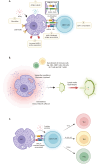Conventional and non-conventional antigen presentation by mast cells
- PMID: 38567067
- PMCID: PMC10917180
- DOI: 10.1093/discim/kyad016
Conventional and non-conventional antigen presentation by mast cells
Abstract
Mast cells (MCs) are multifunctional immune cells that express a diverse repertoire of surface receptors and pre-stored bioactive mediators. They are traditionally recognized for their involvement in allergic and inflammatory responses, yet there is a growing body of literature highlighting their contributions to mounting adaptive immune responses. In particular, there is growing evidence that MCs can serve as antigen-presenting cells, owing to their often close proximity to T cells in both lymphoid organs and peripheral tissues. Recent studies have provided compelling support for this concept, by demonstrating the presence of antigen processing and presentation machinery in MCs and their ability to engage in classical and non-classical pathways of antigen presentation. However, there remain discrepancies and unresolved questions regarding the extent of the MC's capabilities with respect to antigen presentation. In this review, we discuss our current understanding of the antigen presentation by MCs and its influence on adaptive immunity.
Keywords: CD4 T cell; CD8 T cell; DC; antigen presentation; mast cells.
© The Author(s) 2023. Published by Oxford University Press on behalf of the British Society for Immunology.
Conflict of interest statement
None declared.
Figures



Similar articles
-
Human mast cells present antigen to autologous CD4+ T cells.J Allergy Clin Immunol. 2018 Jan;141(1):311-321.e10. doi: 10.1016/j.jaci.2017.02.048. Epub 2017 Jun 15. J Allergy Clin Immunol. 2018. PMID: 28624612
-
Mast cells regulate CD4+ T-cell differentiation in the absence of antigen presentation.J Allergy Clin Immunol. 2018 Dec;142(6):1894-1908.e7. doi: 10.1016/j.jaci.2018.01.038. Epub 2018 Feb 20. J Allergy Clin Immunol. 2018. PMID: 29470999 Free PMC article.
-
Communication between human mast cells and CD4(+) T cells through antigen-dependent interactions.Eur J Immunol. 2013 Jul;43(7):1758-68. doi: 10.1002/eji.201243058. Epub 2013 May 13. Eur J Immunol. 2013. PMID: 23595723
-
Mast Cell Functions Linking Innate Sensing to Adaptive Immunity.Cells. 2020 Nov 25;9(12):2538. doi: 10.3390/cells9122538. Cells. 2020. PMID: 33255519 Free PMC article. Review.
-
Neuro-allergology: Mast cell-nerve cross-talk.Allergol Int. 2022 Jul;71(3):288-293. doi: 10.1016/j.alit.2022.04.002. Epub 2022 Jun 7. Allergol Int. 2022. PMID: 35688775 Review.
References
-
- Matsushima H, Yamada N, Matsue H, Shimada S.. TLR3-, TLR7-, and TLR9-mediated production of proinflammatory cytokines and chemokines from murine connective tissue type skin-derived mast cells but not from bone marrow-derived mast cells. J Immunol 2004, 173, 531–41. doi:10.4049/jimmunol.173.1.531. - DOI - PubMed
Publication types
LinkOut - more resources
Full Text Sources
Research Materials
